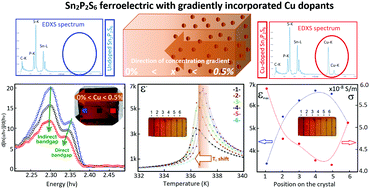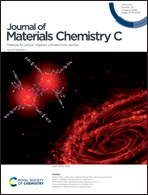Customization of Sn2P2S6 ferroelectrics by post-growth solid-state diffusion doping
Abstract
For the first time, we demonstrated successful post-synthesis incorporation of metal dopants at elevated temperature into a host structure of Sn2P2S6, known as the grandfather of dichalcogenide ferroelectrics with a formula M2P2X6 (M = metal and X = chalcogen). With the example of Cu, we show that the integration of dopant atoms into the bulk of an already grown crystal could be easily tuned up to 0.5 at% affecting the structural, optical, vibrational, electrical, and ferroelectric properties. Thermally diffused copper atoms in Sn2P2S6 bulk are in the metallic state, inducing a multiaxial expansion of the Sn2P2S6 unit cell for 2–3.4%. The energy reduction between indirect and direct optical transitions was observed, combined by small hardening for acoustic and soft optical vibrational modes originating in the partial substitution of Sn by Cu in the Sn2P2S6 crystal lattice. Similar to hydrostatic pressure, the structurally bonded copper initiates a small downward shift in the critical temperature Tc. The presence of copper has a substantial impact on the shape smearing of the ferroelectric domains as well as on the behaviour of the dielectric permittivity. The real part of the dielectric constant ε′ reaches its maximal value at intermediate concentrations of Cu 0% < x < 0.5%, showing an ∼20% increase with respect to the parent structure. The incorporated metal atoms provoke a monotonous expansion of the ferroelectric P–E loops along the increased dopant content direction. An increase in the electrical conductivity at higher Cu concentration reveals a trend for inducing a metal-like behaviour.



 Please wait while we load your content...
Please wait while we load your content...